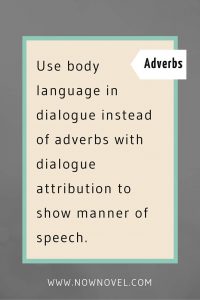‘Don’t use adverbs. Only ever use descriptive verbs.’ This is a writing ‘rule’ often repeated, partly thanks to Stephen King’s strong views on the subject. It’s true that beginning authors often use adverbs to cover up bland dialogue or action. You don’t have to avoid adverbs completely, however. Here are 7 ways to make sure you don’t use adverbs the wrong way in your action and dialogue:
1: Use descriptive verbs
Beginning authors often tack adverbs ending ‘-ly’ onto nondescript verbs. The verb ‘to run’ indicates a degree of speed, but isn’t particularly descriptive. A novice writer might add adverbs such as ‘quickly’ or ‘hurriedly’ to describe a character’s movement. Yet you can use descriptive verbs that make extra describing words unnecessary: ‘She rushed’, ‘she sprinted’ or ‘she darted’.
Descriptive verbs are preferable because:
- They are more concise and concise writing is punchy
- They are more specific (ways of moving borrowed from the animal kingdom, for example, such as ‘stampeding’, conjure up vivid mental imagery)
Instructors who say you should never use adverbs in your writing forget that there are many kinds of adverbs, including descriptive phrases:
2: Use adverbial clauses instead of standalone adverbs
Adverbs ending ‘-ly’ can become crutches, but longer adverbial clauses are often highly descriptive. An adverbial clause is a group of words functioning as an adverb. Take the sentence ‘She ran as though a deadly avalanche tore down the slope behind her in pursuit.’ The clause beginning ‘as though’ describes the woman’s manner of running. Because the adverbial clause here contains an ominous image (we know that being caught in an avalanche is potentially fatal), we understand that the character is running due to some or other threat or fear.
Describing verbs with adverbial clauses lets you add emotion and intensity to characters’ actions. For example, compare ‘he laughed loudly’ and ‘He laughed as though some huge horn in his gut was squeezed by an unseen hand. His laughter came in uncontrolled, blasting bursts.’
3: Create descriptive sequences of actions
Creating descriptive sequences of actions, some of which belong to your character and some of which describe their surrounds, will help you to rely on adverbs less.
For example, if a character in your story has to catch the last train home but she’s running late because of a meeting, you could write ‘she ran quickly to the station, afraid she’d miss her train’. Better would be ‘she sprinted to the station, afraid her train had already left.’ But you can also create a sense of action and hurriedness by describing your character’s surrounds and actions independent of her:
‘She reached the terminals as the grill closing off the station platform started to descend. She ducked under it and sprinted for the train that was already throbbing into gear.’
Here, a sequence of actions creates the overall effect of hurry and panic. Actions independent of the character (the lowering grill at the turnstile and the train’s throbbing in place) add to the sense of not having a moment to spare.
Create vivid scenes by describing both character-based and character-independent actions. This will make your scenes alive without standalone adverbs. Read examples of effective character description in our descriptive writing guide.
4: Use body language in dialogue to indicate manner of speech
Dialogue is an imporant component of vivid multi-character scenes. One of the things that motivated Stephen King to declare war against the adverb is the use of adverbs in dialogue attribution. King gives the following as examples of weak dialogue attribution:
‘‘Put it down! she shouted menacingly.
‘Give it back,’ he pleaded abjectly, ‘it’s mine.’
‘Don’t be such a fool, Jekyll,’ Utterson said contemptuously.’
What makes these lines of dialogue weak is that in each the adverb is redundant. If a character is shouting, aggression is implied. ‘Menacingly’ in the first example doesn’t tell us anything we don’t know already. The same goes for the second example – a character ‘pleading’ implies that the character is in a subservient or abject state. In the third, the character’s actual words are so laden with contempt that the adverb ‘contemptuously’ simply restates what the reader knows.
If you want to make your characters’ feelings clear in dialogue, you can use gestures and body language instead of adverbs. For example:
‘I could make you disappear, just like that.’ He leaned over the desk towards me, snapping his fingers.’
Instead of relying on verb descriptions that make dialogue attribution feel stagey, use movement and gesture to enliven characters’ conversations.
5: Avoid redundant adverbs
As King’s examples above show, unnecessary adverb use lies behind many cautions to avoid adverbs. So his advice should be qualified: Avoid redundant adverbs.
How many times have you read phrases such as ‘she smiled happily’ or ‘he wailed inconsolably’? These adverbs are redundant because the emotional state of the character is already implied by the verb. We know that happy people smile and that people who are upset enough to cry aloud are likely inconsolable.
If you want to convey that a character is overjoyed, you could use a stronger verb for smiling such as ‘grinned’ or ‘beamed’. Or else you could enrich the gesture with action, as described in point 4. For example: ‘She grinned and did an odd little jig – her excitement palpable.’
6: Use degrees of adverbs to make actions more interesting
Matt Moore raises a good point when he advises writers to be cautious of rigid rules about adverbs. One creative way to use adverbs is to qualify them using words such as ‘almost’. Moore gives the following example:
‘It was how she examined and selected the limbs that freaked Teller out. Gently, delicately. Almost lovingly.’
The adverb shows the character reaching for a way to describe what is unsettling about the other’s actions. It also suggests the character doesn’t want to see the morbid act as loving (the ‘almost’ suggests resistance to the notion).Vague terms describe the action because the action itself is vaguely unsettling and offputting to the character.
Keep in mind then that an adverb can be just the right tool if you use it to achieve a specific effect.
7: Learn how to describe verbs through mood and tone
Learning how to describe verbs using tone and mood will help you rely less on clumsy adverbs. For example, if you write about an eerie building that seems haunted, creating a vivid enough impression of this setting will make readers imagine dialogue and actions in a suitable register. For example:
‘Immediately, upon entering the room, I felt a strange energy that permeated everything through and through. I edged closer to Sarah. “Let’s get out of here,” I urged.’
In the above example, the tone set before any words are spoken makes it clear that there is something eerie going on. Any actions or dialogue following are tainted by this mood, making excessive verb descriptions unnecessary. Strong verbs (such as the tense ‘I urged’) do add to the overarching sense of unease, however.
Instead of blindly following any writing rule, think about why rules such as ‘don’t use adverbs’ are repeated so often. Whenever you think about using an adverb, first ask: Is there a stronger verb that could describe this action concisely? Am I including enough contextual mood and tone to ground characters’ actions and dialogue in their surrounds? When you can pinpoint why you’re using a given adverb (and you only use one if you have a good reason to do so), your writing will improve.
Start getting helpful feedback on your dialogue and action scenes and finish writing a book.
What do you think about the ‘no adverbs’ rule?




4 replies on “Descriptive verbs: 7 tips for avoiding weak adverbs”
Brilliant post! I’ve always tried to avoid adverbs, but this details their positive uses so well! Love the examples, too 🙂
Thanks so much, Amy! Glad you enjoyed this.
Great article, I’m an adverb addict – hopefully on the road to recovery.
Hi Sondra, thank you. At least you’re in recovery!